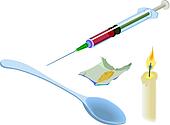As with other opioids, diacetylmorphine is used as both an analgesic and a recreational drug. Frequent and regular administration is associated with tolerance and physical dependence, which may develop into addiction. Internationally, diacetylmorphine is controlled under Schedules I and IV of the Single Convention on Narcotic Drugs. It is illegal to manufacture, possess, or sell diacetylmorphine without a license in Belgium, Denmark, Germany, Iran, India, the Netherlands, the United States, Australia, Canada, Ireland, Pakistan, the United Kingdom and Swaziland.
Under the chemical name diamorphine, diacetylmorphine is a legally prescribed controlled drug in the United Kingdom, and is supplied in tablet or injectable form for the same indications as morphine is. It is available for prescription to long-term users in the Netherlands, United Kingdom, Switzerland, Germany and Denmark alongside psycho-social care, and a similar programme is being campaigned for by liberal political parties in Norway. Some countries allow the government to sell or donate high-quality seizures of drugs and precursors which are otherwise legal for medicinal use to pharmaceutical manufacturers for use in preparing licit supplies of medical drugs and research chemicals; this was the case in Croatia prior to 2007.

No comments:
Post a Comment